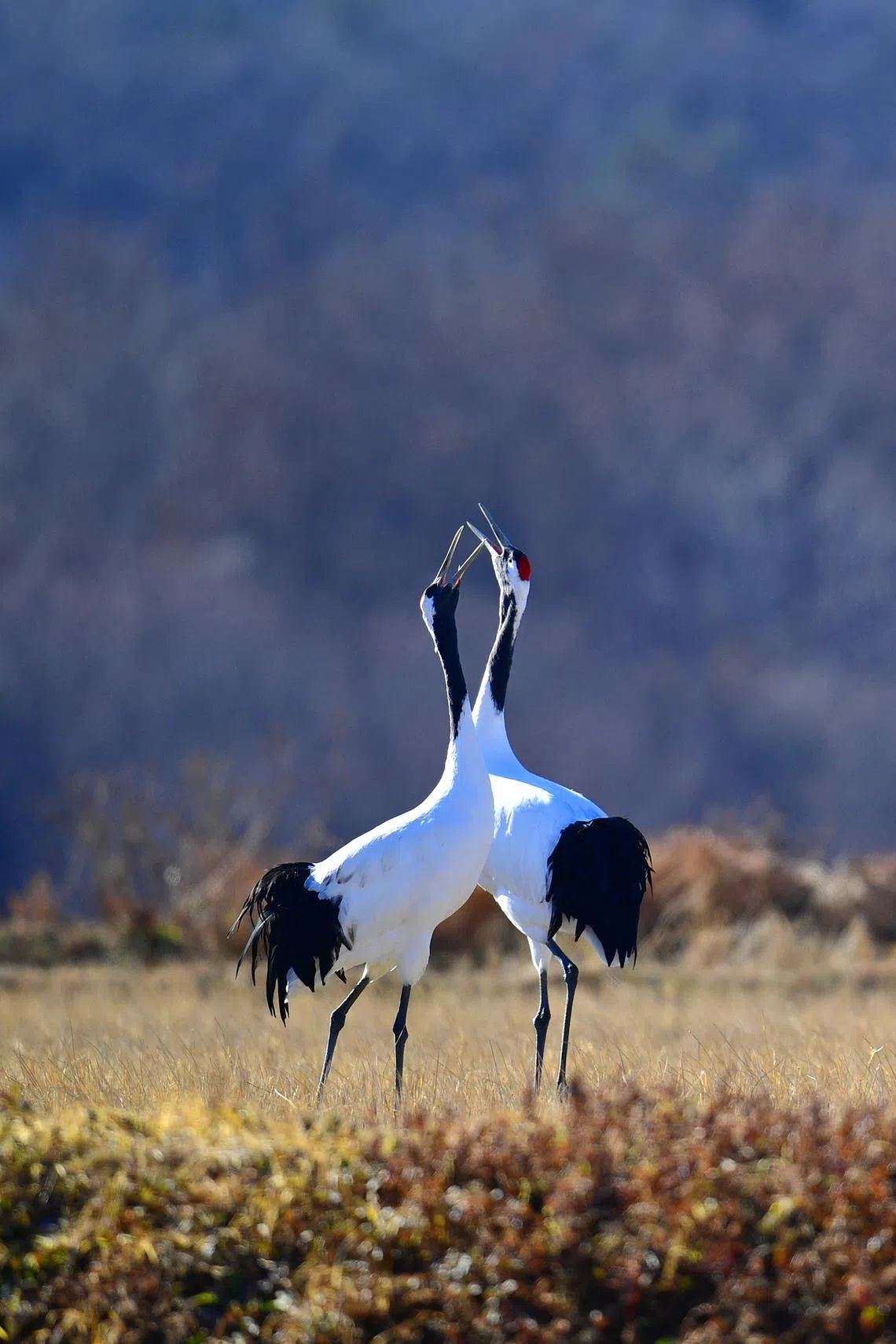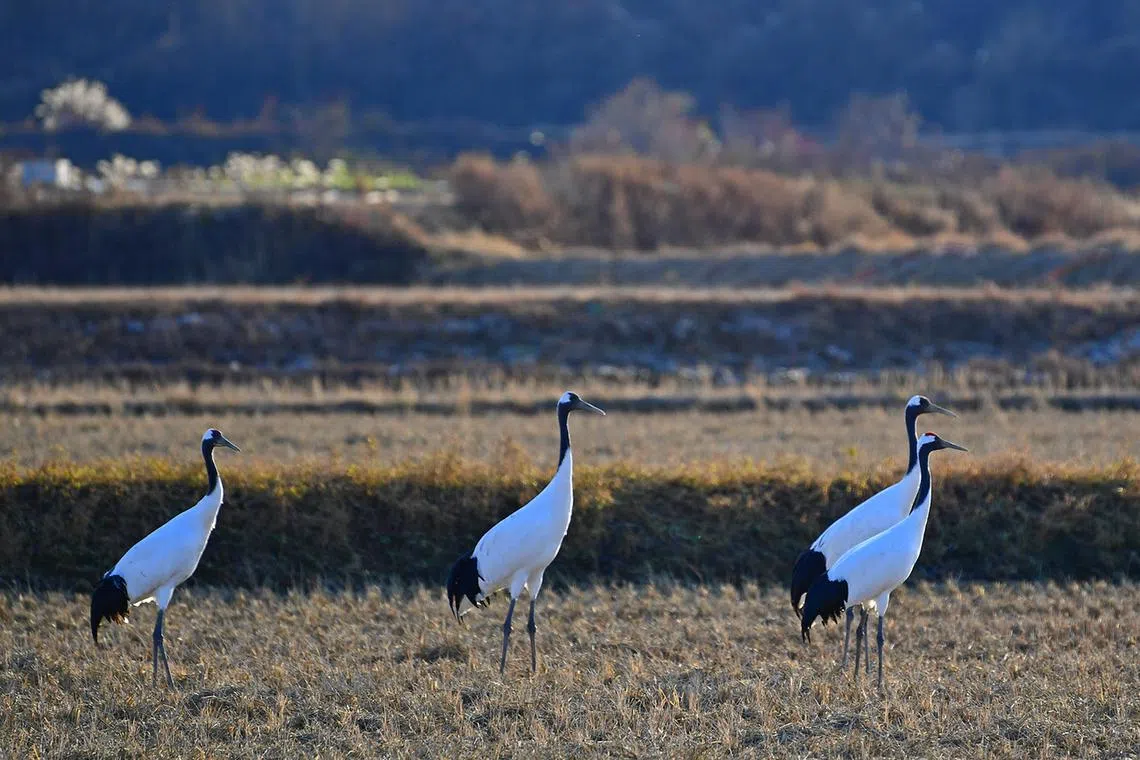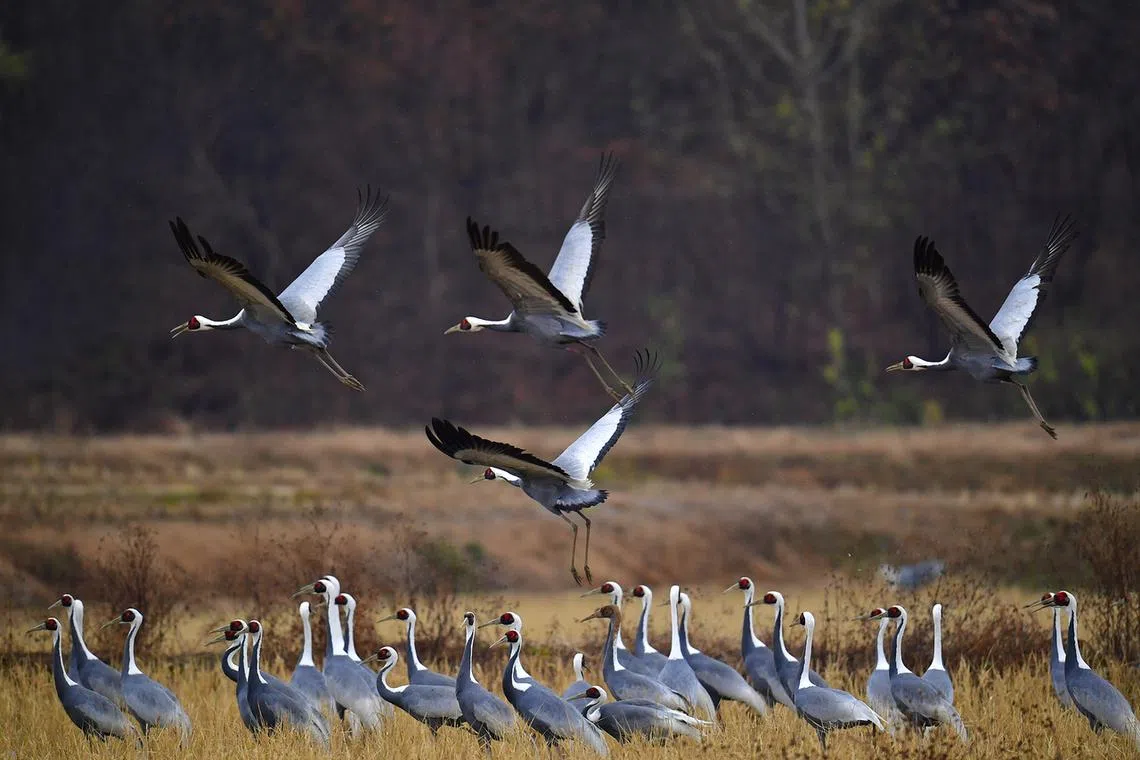Off-limits to humans for 70 years, S. Korea’s border zone becomes sanctuary for rare cranes
Sign up now: Get insights on Asia's fast-moving developments
Follow topic:
CHEORWON, Gangwon Province – Near the border dividing the Korean Peninsula between North and South Korea, a long strip of land has remained off-limits to humans since 1954.
The southern part of this buffer zone, marked by the Civilian Control Line (CCL), takes up about 1 per cent of South Korea’s total land area.
This special set-up has turned the area into a sanctuary for many endangered plants and animals. Of the 282 endangered species in South Korea, 108 can be found here. Cranes are among them.
In January, along the inter-Korean border, nearly 2,600 red-crowned cranes and 10,000 white-naped cranes were observed. This accounts for 57 and 71 per cent of the global populations of these species, respectively, estimated at about 4,500 red-crowned cranes and 14,000 white-naped cranes worldwide.
In the area under the jurisdiction of Cheorwon-gun, Gangwon Province, which spans about 14,992ha, around 1,500 red-crowned cranes and 7,200 white-naped cranes were spotted.
The migratory birds are known to be highly sensitive to human presence, making encounters with them in urban areas nearly impossible. Globally, the opportunity to see cranes in large groups is exceptionally rare.

Cranes are known for their strong pair bonds and are often found in twos.
PHOTO: THE KOREA HERALD/ASIA NEWS NETWORK
Bird-watching tour
For bird-watchers, the Cheorwon regional government operates a special tour programme.
The tour begins at the Demilitarised Zone Peace Town, about two hours’ drive from Seoul, and first stops at a military checkpoint. There, guards remind visitors that they are entering a civilian-restricted area and warn of criminal penalties for photographing military facilities. North Korea’s anti-South propaganda broadcasts can also be heard faintly.
Beyond the checkpoint, farmland, managed by specially permitted farmers from nearby villages, creates a peaceful scene.
Cranes dot the fields – typically in pairs, as cranes are known for their strong pair bonds. Occasionally, groups of three are spotted, with one being a juvenile, according to tour guide Lee Bong-woo.
He said each field functions as a “home” for a crane couple. Some larger groups, usually consisting of younger cranes, gather to socialise. Despite sharing territories, the peace-loving cranes do not fight, even when neighbours encroach on their space, he said.
Interestingly, when the electric bus nears, the cranes do not flee. “When the tours began in 2022, they would fly away at the sight of the bus. But now, they seem to perceive it as non-threatening,” said Mr Lee. Cranes, known for their intelligence, communicate using over 60 vocalisations and gestures.
Kang Mi-jin, an 11-year-old who introduced herself as a bird enthusiast since the age of six, said, “I came here last year, but this is my first time seeing them in such large groups. It’s incredible. I want to come back next year.”

Despite sharing territories, the peace-loving cranes do not fight, even when neighbours encroach on their space.
PHOTO: THE KOREA HERALD/ASIA NEWS NETWORK
Why Cheorwon?
The cranes build nests and breed in wetlands along Russia’s Amur River, laying two eggs in March or April. By October, they migrate to warmer regions in Ganghwa, Paju, Yeoncheon and Cheorwon in South Korea, as well as Japan.
Previously, many cranes continued to Japan’s Izumi, but according to the Cheorwon regional government, more are now choosing to remain in Korea before returning to Russia.
Cheorwon is ideal for cranes because human activity is restricted, rivers remain unfrozen during winter and reservoirs provide safe sleeping grounds away from predators like wild cats, which avoid water. The vast farmlands offer an abundant food supply, including grains left after harvest, fish, clams, amphibians, insects and plants. Fertile soil and clean air and water ensure minimal exposure to harmful pests and chemicals, the government said.
The city strives to ensure its winter visitors have a comfortable and restful stay.
Cheorwon encourages farmers to leave rice straw in their fields after harvest, providing an essential food source. Farmers receive an annual subsidy of 1.1 billion won (S$1.02 million) under the condition that they do not plough the fields or apply liquid fertilisers. Additionally, the government scatters corn and rice seeds to supplement the cranes’ diet.
In 2024, an extended summer caused rice plants to germinate prematurely, resulting in empty grains and reducing food availability for the cranes.
Observing cranes staying outside the CCL earlier than usual, manager Lee Gye-ok of the city’s crane environment division, felt the effect of climate change. “I thought they have less to eat this year.”

Cheorwon is ideal for cranes because human activity is restricted, rivers remain unfrozen during winter and reservoirs provide safe sleeping grounds away from predators like wild cats, which avoid water.
PHOTO: THE KOREA HERALD/ASIA NEWS NETWORK
Growing threats from human activity
This haven for cranes, however, is experiencing changes that may seem trivial to humans but could be life-threatening to the birds.
The rise of greenhouses is one such change.
The vast farmland, cultivated by farmers from nearby villages and serving as a habitat for cranes, once primarily produced grains. However, with rice consumption declining in the country, farmers are shifting to other crops that require greenhouses, which then leads to more electric wires, the city official Lee explained.
“When cranes fly at high speeds, they sometimes fail to avoid the wires, resulting in fatal collisions. To address this, yellow warning markers have been added to the wires to make them more visible to the birds.”
Another growing concern is the increasing installation of solar panels in the region.
“Solar panel installations disturb air currents crucial for cranes migrating from Russia. The glare from sunlight reflecting off the panels also disrupts their flight,” Mr Lee said. Additionally, solar panels, which cover vast areas, lead to habitat loss for the cranes, rendering surrounding areas uninhabitable.
Over the past 10 years, more than 700 solar power projects have been approved in Cheorwon.
Cheorwon Crane Association head Yoo Jong-hyun pointed out that “outsiders are exploiting rural areas purely for profit without any consideration for the residents or the environment, which is causing serious issues”.
Despite ongoing efforts to balance human development and crane conservation, Mr Lee stressed the urgency of protecting the cranes’ habitat.
“Cheorwon serves as one of the last regions where cranes inhabit. If it falls, cranes will vanish from the Earth, just like the dinosaurs.” THE KOREA HERALD/ASIA NEWS NETWORK

